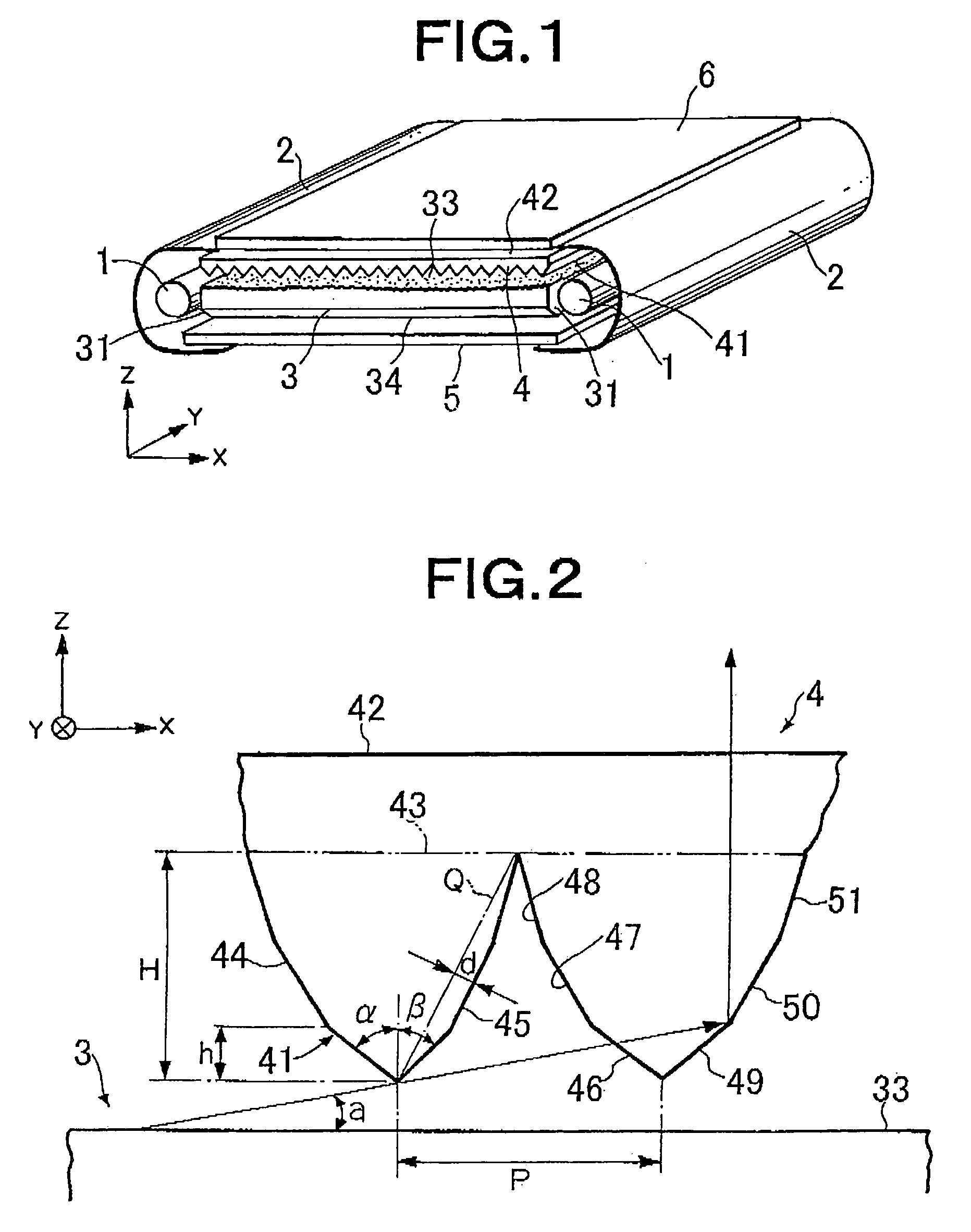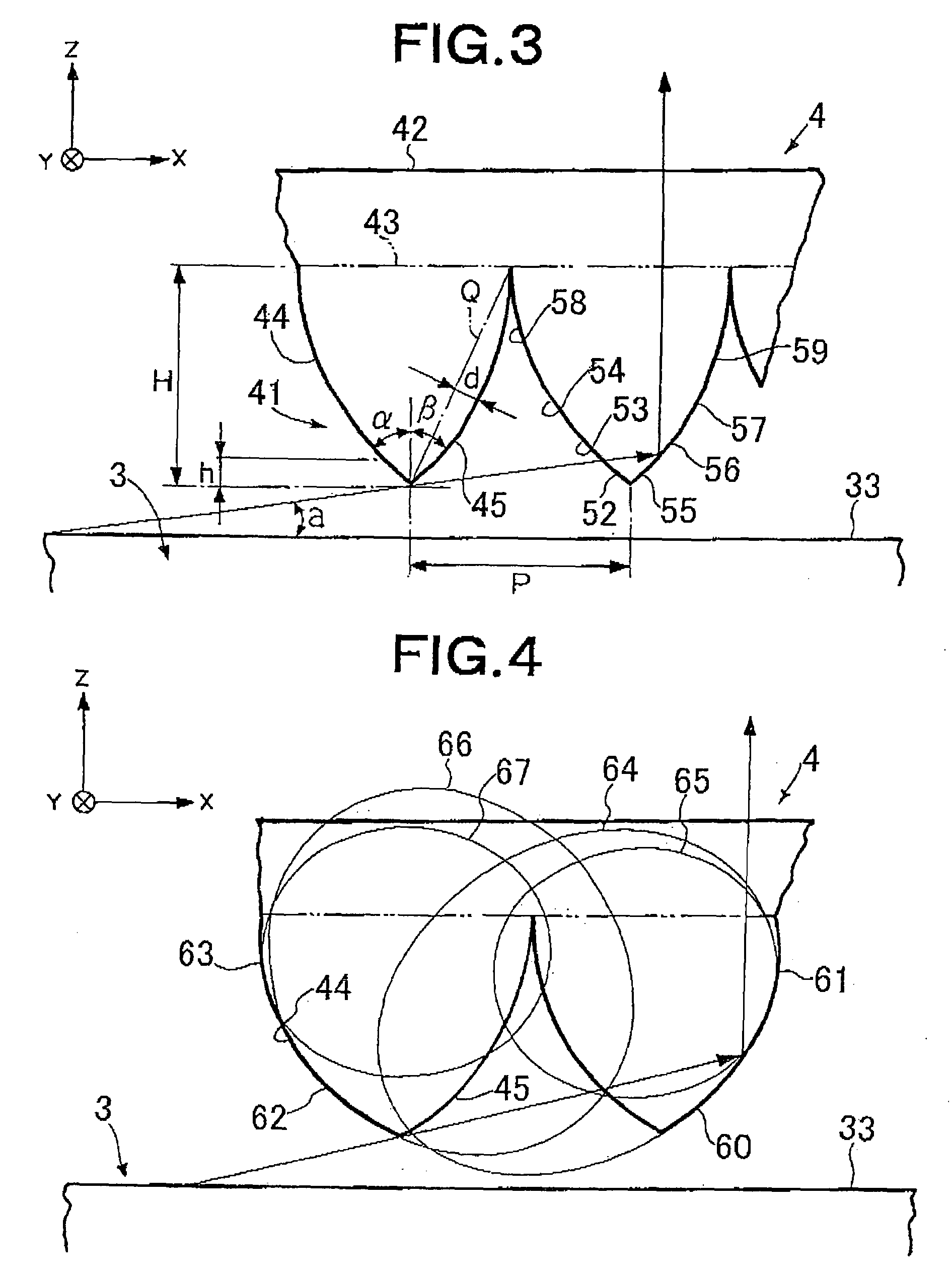Light source device and light polarizing element
light polarizing element technology, applied in the field of light source devices and light polarizing elements, can solve the problems of insufficient narrowing or extremely narrowing of the distribution of outgoing light from the light guide, and the practicality of a light source device with a relatively large size is inferior, and achieves small reduction of luminance, improved luminance, and high light condensing effect.
- Summary
- Abstract
- Description
- Claims
- Application Information
AI Technical Summary
Benefits of technology
Problems solved by technology
Method used
Image
Examples
examples 1 to 9
[0087]Using an acrylic resin (Acrypet VH5#000 produced by Mitsubishi Rayon Co., Ltd.), there were prepared, by injection molding, 14-inch light guides each having a size of 210 mm×300 mm with a thickness of 6 mm. Each light guide had one surface in the form of a mat having an average inclination angle of 8 degrees and the other surface having elongated prisms successively arrayed parallel to each other at a pitch of 50 μm and with a prism vertical angle of 100 degrees and each extending perpendicular to sides each having a length of 300 mm (long sides) of the light guide. Cold-cathode tubes were disposed along both side end surfaces corresponding to the sides of 300 mm (long sides) of the light guide, while the cold-cathode tubes were each covered with a light source reflector (silver reflection film produced by Reikosha) Further, light diffusion reflection films (E60 produced by Toray Industries, Inc.) were stuck to the other side end surfaces, and a reflection sheet was disposed o...
example 10
[0093]A prism sheet was prepared like in Example 1 except that, as shown in Table 2, each of both prism faces forming each elongated prism was formed by two flat faces (areas 1 and 2 from the side of the prism vertex portion), i.e. a flat face (β=32.0 degrees) formed from the prism vertex portion to a height 17.1 μm (h′) of the elongated prism and having an inclination angle of 58.0 degrees, and a flat face formed from and above the height 17.1 μm of the elongated prism and having an inclination angle of 62.0 degrees.
[0094]The obtained prism sheet was placed such that the elongated-prism formed surface was oriented toward the light outgoing surface of the same light guide as in Example 1 and the prism ridgelines were parallel to the light incident surfaces of the light guide, thereby obtaining a surface light source device. There was derived an outgoing light luminance distribution (in the XZ-plane) in the plane perpendicular to both the light incident surface and the light outgoing...
example 11
[0095]A prism sheet was prepared like in Example 1 except that, as shown in Table 2, each of both prism faces forming each elongated prism was formed by two flat faces (areas 1 and 2 from the side of the prism vertex portion), i.e. a flat face (β=32.0 degrees) formed from the prism vertex portion to a height 17.1 μm (h′) of the elongated prism and having an inclination angle of 58.0 degrees, and a flat face formed from and above the height 17.1 μm of the elongated prism and having an inclination angle of 60.0 degrees.
[0096]The obtained prism sheet was placed such that the elongated-prism formed surface was oriented toward the light outgoing surface of the same light guide as in Example 1 and the prism ridgelines were parallel to the light incident surfaces of the light guide, thereby obtaining a surface light source device. There was derived an outgoing light luminance distribution (in the XZ-plane) in the plane perpendicular to both the light incident surface and the light outgoing...
PUM
 Login to View More
Login to View More Abstract
Description
Claims
Application Information
 Login to View More
Login to View More - R&D
- Intellectual Property
- Life Sciences
- Materials
- Tech Scout
- Unparalleled Data Quality
- Higher Quality Content
- 60% Fewer Hallucinations
Browse by: Latest US Patents, China's latest patents, Technical Efficacy Thesaurus, Application Domain, Technology Topic, Popular Technical Reports.
© 2025 PatSnap. All rights reserved.Legal|Privacy policy|Modern Slavery Act Transparency Statement|Sitemap|About US| Contact US: help@patsnap.com



